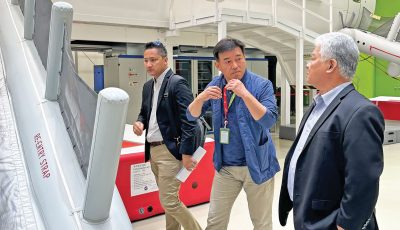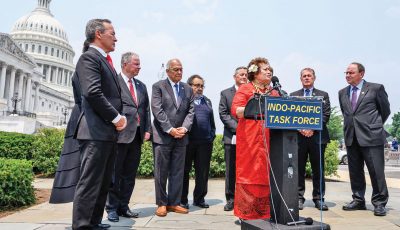A downpour
Special to the Saipan Tribune
Shenyang is always overcast these days so I bring my umbrella to the language center I go to on weekend afternoons to instruct a class of elementary grade students. For an hour and a half, with guardians (mostly mothers) in attendance, I teach students Oral English, and give trainers’ training to the guardians so that they too can join their children in the learning process.
Our methods are unorthodox compared to the regular classes that go by the book (Cambridge prints the texts, which are simply a copy of British materials adopted to Chinese pictures); our quixotic effort a drop in the bucket to a massive book-centered industry of training China’s young in the second language that the nation has adopted. I get the product of 10-year’s worth of book instructions at the university level where students pass writing and reading tests, but are incapable of speaking the language at all.
After Sunday’s session, I walked out into a downpour. One of the parents offered a ride but I declined since I value the walk as one of my exercises to counter the bulging middle. What normally takes less than a 10-minute walk ended up to be 30. The downpour flooded the street reminiscent of another one the week before that we wrote about when we were stuck in traffic of a three-mile ride from the Metro in a taxi we ended up pushing.
From our ground level perspective, the drainage and sewage systems are working in this new development district of Daoyi north of Shenyang city, but like other construction efforts, the design and construction are made to meet minimum standards. With the radical alteration brought about by climate change, it is no longer enough. (The building of structures to meet minimum standards was revealed in the Fukushima nuclear plant where safeguards proved inadequate.)
China’s construction industry has become almost like the U.S. New Deal’s “public works” counterpart in providing employment since the government essentially guarantees much of the financing, so construction proceeds without regard to customer satisfaction. One only has to Google abandoned cities and idle apartment buildings to discover the extent of the non-performing assets built on the ground.
With the rush to construct, the meeting of adequate safety standards is often missing. Today, it became obvious that the absorptive capacity of the streets and the yards is not sufficient to handle unaccustomed downpours. We finally walked barefoot as the waters rushing through the sidewalks into the streets got ankle deep.
We wondered how the city fared since our previous experience had been an uncomfortably wet one, but the news broadcast came with bleaker news. Beijing not only had flash flooding, it also experienced mudslides as a downpour that had not been seen in the area in the last six decades came down and soaked the capital city with a vengeance.
We remember Beijing on our first visit in 1989 when there was only one circular road, and the Metro had yet to make it to the drawing board. It was a picturesque city then, almost like quaint French Indochina, or some sections of the old Shanghai, of broad boulevards and endless stream of bicycle riders. That is, of course, gone.
The traffic jams and gridlocks in Beijing are worse than those of Manhattan. On our last visit, we got stuck for five hours in a gridlock returning from the Great Wall covering a distance that normally takes an hour to drive. That same year, a 62-mile gridlock on the Beijing-Zhangjiakou highway to neighboring Hebei province took 11 days to unravel. Gridlock is a regular occurrence in Beijing; add wetlog and one stares at human disaster.
Beijing is a huge national municipality, but smart enough to build horizontally into satellite cities, though skyscrapers have sprouted if only because of the glossy “face” competition to construct the latest in metropolitan architecture. Precisely due to the rapid construction that has occurred in the last two decades, of highways and subways to service the new glass and steel edifices, the basic engineering to dispose of downpours is missing. For that, young Beijingren are flooding Sino blogs highlighting Tokyo’s underground flood controls to awaken public planners what they missed to provide.
Downpours were not limited to Beijing. From India through Sichuan into Shaanxi, with even normally dry Xinjiang and Nei Mongol unspared, flash floods and mudslides exacted their toll in destruction and human suffering. And we quibble if climate change is just bad science!
A downpour of a different order has descended on other parts of the world. The healing type was in Norway on the first year anniversary of the racially motivated bombing that took 77 lives. The grieving type has gripped the people of Aurora in Colorado for the assault at a midnight screening of the most recent Batman movie by a seemingly smart neuroscience student who plotted long before pulling the trigger.
We are trying to catalyze a downpour of a particular learning that shies away from just passing tests into learning how to live an awakened conscious life. That’s a deluge we are willing and trying to trigger.




























